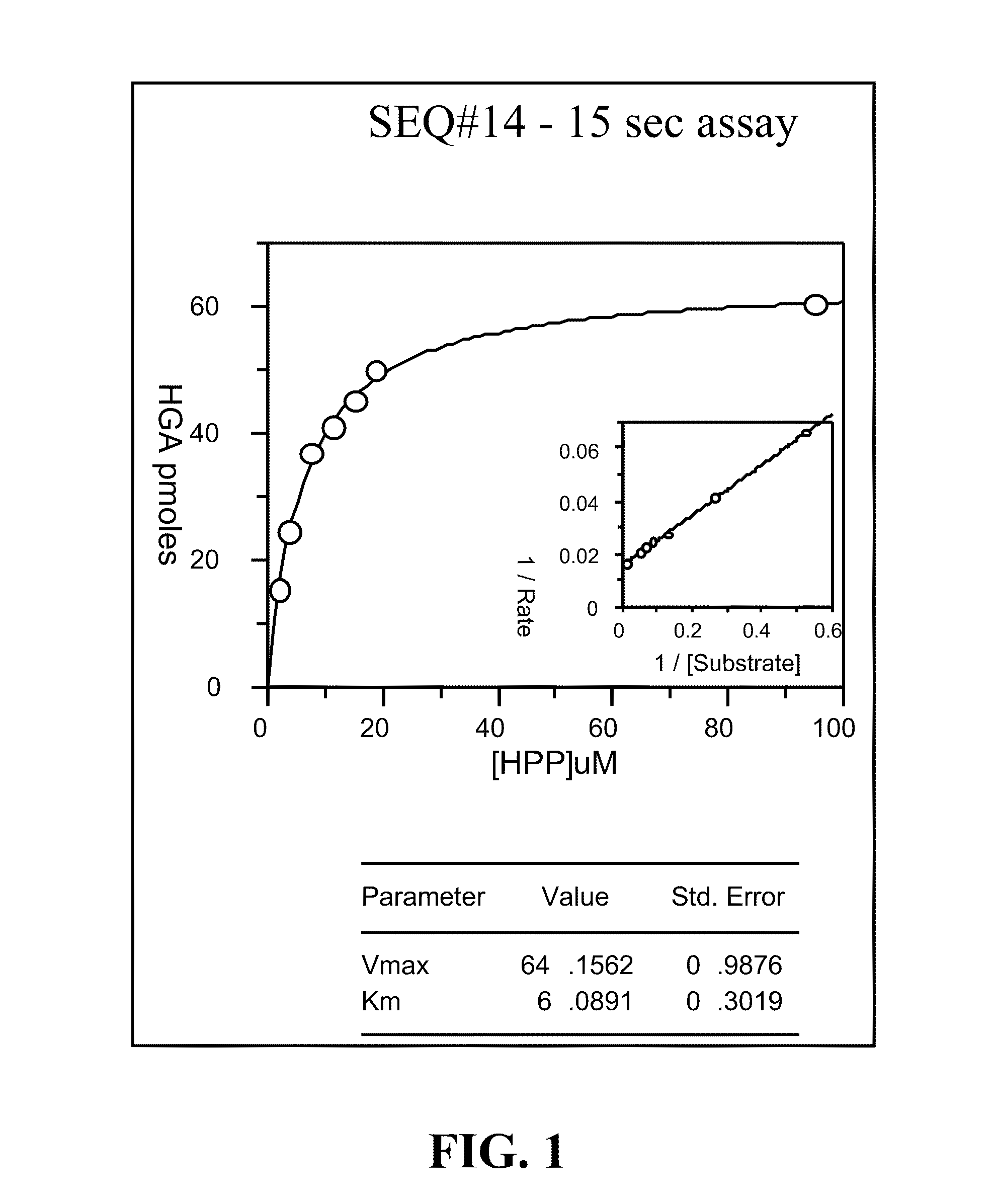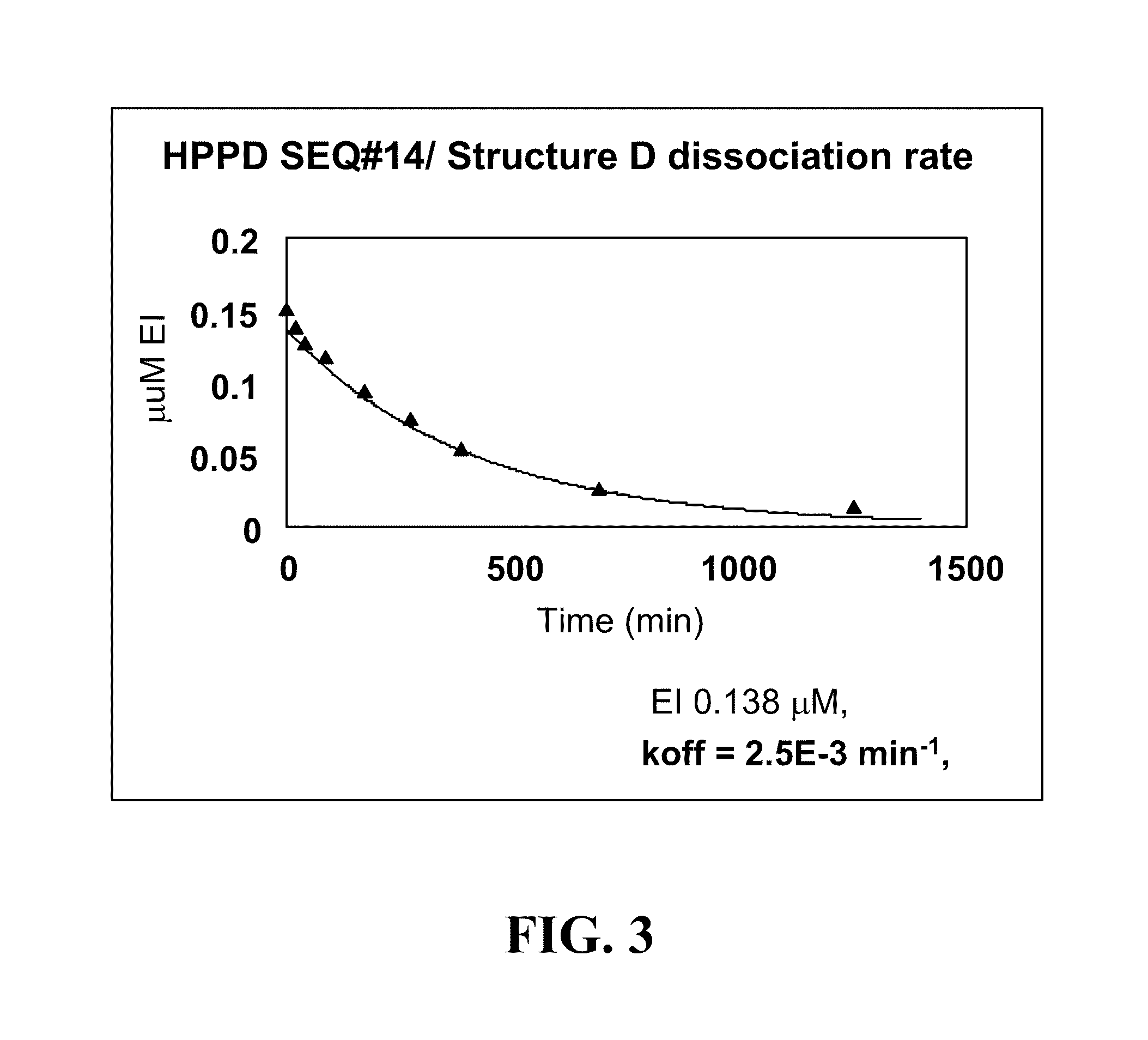Mutant Hydroxyphenylpyruvate Dioxygenase Polypeptides and Methods of Use
a technology of hydroxyphenylpyruvate and polypeptides, which is applied in the field of mutant hydroxyphenylpyruvate dioxygenase (hppd) polypeptides, can solve the problems that the same mutant hppd may be quite inadequate to provide commercial tolerance levels
- Summary
- Abstract
- Description
- Claims
- Application Information
AI Technical Summary
Problems solved by technology
Method used
Image
Examples
example 1
Cloning, Expression and Assay of Avena-derived HPPD SEQ ID NO:14 and Determination of kcat, KmHPP and Ki (kon and koff) Values Versus Various HPPD Herbicides
[0246]The DNA sequence (SEQ ID NO:1) synthesised by GeneArt (Regensburg, Germany) encoding an HPPD derived from Avena sativa (SEQ ID NO:14) was cloned into pET24a and expressed in E. coli BL21(DE3) with 50 μg / ml kanamycin selection as described in PCT App. Pub. No. WO 02 / 46387. Overnight cultures grown at 30° C. were used to inoculate 3×1 litre LB in shake flasks at a ratio of 1:100. Cultures were grown at 37° C., 220 rpm, until an A1cm600 nm of 0.6-0.8 was reached, the temperature decreased to 15° C. and induced with 0.1 mM IPTG. Cultures were grown overnight, and cells harvested after 15 min centrifugation at 10,000 g. Cells were stored at −20° C. until extraction. A cell pellet from 3 litres of shake flask culture (˜12 g) was thawed in extraction buffer (50 mM Tris, 10 mM sodium ascorbate, 2 mM DTT, 2 mM AEBSF, 10 μM trypsin ...
example 2
Cloning, Expression and Assay of Further Variants of Avena-derived HPPDs SEQ ID NOS:12-20 and Determination of kcat, KmHPP and Ki (kon and koff) Values Versus Various HPPD Herbicides
[0279]DNA sequences corresponding to SEQ ID NOS:2-14, encoding HPPD polypeptides corresponding to SEQ ID NOS:15-26 derived from Avena saliva, were synthesized by GeneArt (Regensburg, Germany), cloned into pET24a, and expressed in E. coli BL21(DE3) with 50 μg / ml kanamycin selection as described in PCT App. Pub. No. WO 02 / 46387. Cells were grown, protein extracts were prepared, and HPPD active site titres and kinetic measurements (of kcat, KmHPP, k1, k2 and Ki values) were carried out as described in Example 1.
[0280]Within the present example, the following HPPD sequences were used:
[0281]HPPD SEQ ID NO:15 was changed relative to SEQ ID NO:14 by the substitution of A for Q within the sequence motif GVQHIA (residues 1-6 of SEQ ID NO:55).
[0282]HPPD SEQ ID NO:16 was changed relative to SEQ ID NO:14 by the subs...
example 3
Preparation and Testing of Stable Transgenic Plant Lines Expressing a Heterologous HPPD Enzyme
[0311]In the present example, mutant HPPD genes derived from Avena HPPD were the sequences set forth in SEQ ID NOS:1-13 (optimized for tobacco) or, optionally, are codon optimized according to target crop (e.g., soybean) and prepared synthetically and obtained commercially from GeneArt (Regensburg, Germany). Each sequence is designed to have 5′ Nde1 and 3′BamH1 sites to facilitate direct cloning. For example, the sequences set forth in SEQ ID NOS:11, 12, or 13 are cloned into a suitable binary vector for Agrobacterium-based plant transformation.
[0312]In a particular example genes encoding HPPD SEQ ID NO:14 and HPPD SEQ ID NO: 24 were cloned into identical expression constructs as described below and transformed into tobacco.
[0313]As described in PCT Patent App. Pub. No. WO 02 / 46387, the HPPD encoding nucleotide sequence is edited by PCR (or initially synthesized) to include 5′ Nco1 and 3′ K...
PUM
| Property | Measurement | Unit |
|---|---|---|
| Tm | aaaaa | aaaaa |
| temperature | aaaaa | aaaaa |
| pH | aaaaa | aaaaa |
Abstract
Description
Claims
Application Information
 Login to View More
Login to View More - R&D
- Intellectual Property
- Life Sciences
- Materials
- Tech Scout
- Unparalleled Data Quality
- Higher Quality Content
- 60% Fewer Hallucinations
Browse by: Latest US Patents, China's latest patents, Technical Efficacy Thesaurus, Application Domain, Technology Topic, Popular Technical Reports.
© 2025 PatSnap. All rights reserved.Legal|Privacy policy|Modern Slavery Act Transparency Statement|Sitemap|About US| Contact US: help@patsnap.com



